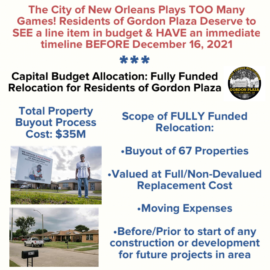
The Sewerage and Water Board is more than meters. They help control flooding with an antiquated system. Things are going be be better hopefully by early 2024.
The New Orleans Sewerage and Water Board will soon break ground on one of its most important construction projects in recent history, the solution to a problem that city leaders have long known about, done little to address and can no longer ignore. Officials expect climate change to fuel increasingly intense rainstorms and hurricanes, turning even humdrum rain events into potential threats. More frequent street flooding is likely, but the extent of any damage will depend on the ability of the city’s drainage system to efficiently channel water away from life and property. S&WB infrastructure is in a precarious state as of now, chiefly because its century-old pumps are powered by an obsolete type of electricity. It must be generated in-house by the S&WB’s steam turbines, some of which are as old as the pumps. And those turbines have repeatedly blown up and broken down in recent years, cutting off the pumps during heavy storms and making street flooding far worse than it would have been otherwise. The solution, city leaders say, is an Entergy substation that ties into the city’s power grid. It will replace the S&WB’s century-old turbines, and comes with special frequency changers that “dumb down” Entergy’s modern power to make it compatible with the city’s ancient pumps until they too are replaced.
nola.com
Entergy New Orleans is a partner in this effort and it will help stabilize the system with consistent power.
The substation idea has been well publicized, and an expected groundbreaking in the next few weeks will be a major milestone on the way to more reliable drainage in New Orleans. What officials have not explained in detail, however, is that the substation is just one piece of a massive undertaking at the S&WB’s Carrollton plant that includes an array of new infrastructure, buildings and equipment. The substation is the centerpiece of the overall project, known as the West Power Complex, which also includes conduits for the new power supply, a new modern turbine, a new operations center and several smaller components to make it all work. But the substation itself represents just a fraction — about 10% — of the cost, which has ballooned in recent months. Officials have spent much of the last year frantically assembling funding sources, a task that has become all the more urgent as some commitments have been stalled or withdrawn.
This is and has been a top priority.
For S&WB Executive Director Ghassan Korban, who is also juggling long-standing problems with overbilling and aging pipes, the substation has been the top priority since taking over in 2018. Korban, previously Milwaukee’s public works director, took the S&WB job on the heels of intense summer storms in 2017 that resulted in five feet of standing water on some city streets and laid bare drainage inadequacies. An analysis later found decades of mismanagement at both City Hall and the S&WB broadly contributed to the failure. More specifically, the report by ABS Group found that three of the S&WB four turbines were disabled during the deluges. That, combined with clogged catch basins and other failures, reduced pumping capacity to less than half of what the system is designed for. “At the moment it’s raining, and whether or not it brings us nine inches of rain, I can’t say I don’t have enough power. That was 2017. We’re not going to repeat the mistakes that we had,” Korban said in an interview.
The price keeps going up and more is needed to set up the substation.
The current $300 million estimated price tag for the new power project marks a 25% increase since June. S&WB officials attribute the spike to higher-than-expected construction bids, and to additional needs that have become apparent in advanced designs. The construction timeframe is creeping back as the costs mount. Last year, officials predicted the substation would be up and running by the fall of 2023. The current estimate is the first quarter of 2024, with additional pieces of the overall project to follow after that. “When you start with a concept, not every piece is considered. Then when you start designing it, and people are sitting down and piecing it together, it just becomes more realistic,” Korban said. The evolving components and cost estimates associated with the West Power Complex have been difficult to track, even for officials who are close to the project. When Korban mentioned the $300 million estimate at the September meeting of the city’s Infrastructure Advisory Board, the chairperson, Paul Flower, said he hadn’t heard that figure before. “I think what would be helpful from Ghassan is a list of scope of work that you’re talking about that you’re putting under that heading,” Flower said in an interview. “Define what you mean by this. Get everybody talking the same language.”
The basic logic of the sub station is easy but the component parts are more nuanced.
The basic logic of the substation with frequency changers has been relatively easy to explain. But officials have eschewed the finer details of how the new system works, including what they broadly refer to as “integration components.” Those include a utility rack that ferries the power from the substation to the S&WB command center. The utility rack is about as costly as the substation itself, as is the set of three frequency changers. A new turbine that runs on modern power is needed to back up the substation in an emergency. The foundations for the frequency changers, transformers, electrical interconnections and a milieu of other pieces add tens of millions of dollars to the overall cost. Once the substation is up and running, the S&WB plans to supplement it with a new operations center, along with new switchgears and tie-ins. Officials say the project is about 75% funded with a mix of sources including city and state capital funding, federal grants, drainage bonds and special fees and taxes dedicated to the S&WB known as “fair share” dollars.
The Board and citn need to explain to us what all is involved and what benefits we receive.
In June 2021, Korban joined his Entergy counterparts and city officials in celebrating a deal to finance the substation, but they left the public with a misleading impression of what the overall project entailed amid all the cork popping. The announced deal included Entergy’s commitment to front $34 million to build the substation, plus $20 million apiece from the city and state. The city portion was for the frequency changers, and the state’s portion was for the integration components. Those pieces combine for the lion’s share of the overall cost and are far costlier than stated in the announcement. In a press release, Mayor LaToya Cantrell called it an “unprecedented partnership” resulting in a “transformative $74 million project,” even though the overall cost estimate has always been at least three times that amount. Separate S&WB releases repeated the incorrect figure. Korban stressed that the actual cost estimate, while significantly increasing in recent months, has not tripled from the $74 million partial cost of the project that was announced last year. “Whether we’ve elaborated on that or discussed that with clarity, maybe not,” Korban said. Council member Joe Giarrusso, who has participated in a working group with utility executives focused on the project, said the finer details had been overlooked when the deal was announced. “We were so singularly focused on the frequency changers and the substation that the discussion of the West Power Complex was collateral to what we thought our primary mission was,” Giarrusso said. “In the back of my brain, I knew that there was something of an integrated system. But in the front, I don’t think I really knew until fairly recently how all of the pieces fit together.”
Entergy is also at fault for the delay as is the Attorney General in his quest to ban abortions.
Entergy backed out of its financing commitment within six months of last year’s announcement, forcing officials to scramble for funding. The Cantrell administration agreed to fill the gap. The resolution arrived just in time for another hiccup: the State Bond Commission held up $39 million in state capital funding amid Attorney General Jeff Landry’s political dispute with city leaders over Louisiana’s abortion ban. The commission finally approved the funding in September. The financing snafus focused the public’s attention on disparate aspects of the project, once again obscuring the overall cost and complexity. Korban acknowledged that the project has not been very well explained to the public, but he added that previous generations of city officials aiming to solve the S&WB’s power morass have focused too much on daunting details before getting started. “They just couldn’t get aligned. They focused too much on who pays and who won’t,” Korban said. “Let’s rally behind the concept itself. Does it make sense for the city? Yes. Well, okay, then everything else becomes an exercise of how we can move it forward.”
We need this and quickly as this has been an unusual hurricane season. Just think of what could have been done if they started six months ago.



